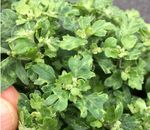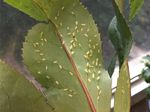Aphids in Unexpected Places - e-GRO
←
→
Page content transcription
If your browser does not render page correctly, please read the page content below
Dan Gilrein
dog1@cornell.edu
Volume 10 Number 5 February 2021
Aphids in Unexpected Places 2021 Sponsors
Over the years trivia tends to accumulate, including in the
Diagnostic Lab, and for the benefit of posterity the internet
offers one possible repository for possibly useful material not
necessarily destined for library archives. Over the past year I had
some interesting samples of and questions about aphids, so as
winter transitions to spring I’ll use the opportunity to review
some of the less common species we’ve encountered in
greenhouses over the years while issuing the standard reminder
to watch for early signs and respond while infestations are still
small in size and area. Focus most attention on older plants,
area with weeds beneath benches (where aphids may persist)
and vegetatively propagated material.
Recognizing the aphid species present can be important for
determining the correct biocontrols to use, to help understand
why biocontrols released aren’t working well, and to detect the
presence of a potentially damaging pest new to the area. At
least one insecticide (Sarisa) is labeled only for one particular
species (melon aphid) and we’ve found some aphids can be less
susceptible to certain insecticides or have a reputation for
tolerance, which some learned the hard way after finding
treated calibrachoa hanging baskets with unexpected infestions. Reprint with permission from the
The most common aphid species we see in greenhouses include author(s) of this e-GRO Alert.
green peach (Myzus persicae), melon (Aphis gossypii), foxglove
(Aulacorthum solani) and potato aphids (Macrosiphum
euphorbiae) and it’s not too hard to distinguish these. One
website with some excellent photos and information is
https://influentialpoints.com/Gallery/Aphid_genera.htm.
Although more Europe-focused, the site includes these and other
species and information relevant to North American readers.
Searching the internet with the species’ Latin names will also
turn up additional helpful information and images.
www.e-gro.org
1e-GRO Alert - 2021 Aphids in Unexpected Places
Many aphids have distinctive colors,
markings, and host associations all of
which can all be helpful in identification.
If you need to have aphids identified, try
to snap some good, clear photos, getting
as close to the subject as possible while
under good lighting, collect samples of
adult aphids (both non-winged and winged
variants if possible) into rubbing alcohol
and submit all to a diagnostic lab with
information on hosts, aphid color in life,
any symptoms of plant injury, etc.
Macrosiphum subterranean aphids on Shasta daisy
Since the common species are often
discussed and were the subject of past
Alerts, the following is a discussion of a
few of the more interesting but less
encountered species I have seen over the
years. Chances are most won’t find these
with any regularity, but given the
constantly changing spectrum of plants
and history of invasive species perhaps
this will help raise awareness – and
observant growers may actually find
species new to the region or the country.
Most of these have several to many plant
hosts, but some aphids are quite host-
specific among which growers may find a
candidate for use with ‘banker plants’ Hellebore aphids
that maintain beneficial insects in the
absence of pests without threatening the
crop. And to keep things interesting,
“new” aphids sometimes hide in plain
sight: identical-appearing biotypes of
common aphids sometimes exhibit new
behaviors or host preferences.
Hellebore aphid (Macrosiphum hellebori)
A rather large greenish aphid, possibly
from Europe and confined to an unusual
host (only 4 aphid species are known
associated with Helleborus), I
encountered this in a Long Island, NY
sample in 2020, the second US report. The
honeydew on leaves drew attention to the
Tulip bulb aphid on iris
aphids beneath, but otherwise there was
no visible impact on the plant.
www.e-gro.org 2e-GRO Alert - 2021 Aphids in Unexpected Places
Leaf curl plum aphid and injury to chrysanthemum Crescent-marked lily aphid on lily
Leaf curl plum aphid (Brachycaudus helichrysi)
Variously colored pale green, yellow or pinkish, I have seen this species several times on
mums and often clustered around or just below buds and terminal growth. It is
sometimes associated with leaf discoloration and distortion. The aphids, relatively small
as aphids go, are well-camouflaged and cryptically settle where they’re not easily
observed until damage is apparent and populations very high. Plants in the same family
as mums are often hosts, but it will feed on other types of plants as well. Some
populations have an overwintering generation on various Prunus.
Tulip bulb aphid (Dysaphis tulipae)
Some years ago a perennial grower forcing bearded iris rhizomes found very large
numbers of this grayish, waxy aphid on leaf fans. That same year we also found them on
crocuses being forced. Some aphids, like this one, can live on roots and move onto new
growth in spring. Hosts include many spring bulb plants (lilies, crocus, gladiolus, etc.)
and a few others (Musa, Strelitzia, Arum). In one trial we found the aphids weren’t
difficult to control, but their waxy coating and the vertical, waxy foliage made spray
coverage a bit challenging.
Macrosiphum subterranea
Several years ago I encountered this unusual species on Shasta daisy, probably its main
host, known to be widespread in Europe and found in a few US locations. The aphids are
dark reddish-brown (almost black) with gray markings or bands and were mainly under
leaves.
Onion aphid (Neotoxoptera formosana)
Found on greenhouse garlic chives, the dark reddish-brown aphids feed on Allium bulbs
and foliage. While damage was not apparent, the aphids were extremely visible against
www.e-gro.org 3e-GRO Alert - 2021 Aphids in Unexpected Places
the green foliage, causing plants to be Crescent-marked lily aphid (Neomyzus
rejected for shipment. circumflexus)
Bean aphid (Aphis fabae) A green or yellow-green aphid with
distinctive black markings on the back
I often see this outdoors in summer (immature stages lack the dark markings),
clustered on upper stems of lambsquarters I have encountered it on lilies where it
(weed), but in the greenhouse it’s been on apparently arrived with the bulbs,
nasturtium, spinach, chard, and following the new growth as it emerged. It
occasionally other hosts. The dark grayish is sometimes found in colonies with other
to almost black aphids sometimes have species. Despite the very wide host range
small, white patches of dusty wax on the (begonia, fuchsia, mums, ferns, and over
back, with pale banding on legs. This 20 others) it is infrequently encountered.
species has been difficult to manage with
biocontrols. Outdoors, an overwintering Root aphids (several species)
stage may be found in spring on young
shoots of Euonymus causing leaf curling Growers sometimes encounter bright
and stunting. There are a number of white powdery spots on roots of plants, in
subspecies with varying host preferences. some cases mistaking these for
mealybugs. Several aphid species live in
Rice root aphid (Rhopalosiphum such colonies, producing the white
rufiabdominale) protective wax that helps deter excess
moisture. Some we’ve seen include one on
Dark greenish to brownish, this one can be Iberis (possibly cabbage root aphid,
found on roots and on above-ground plant Pemphigus populitransversus), on
parts, including some grasses and Lysimachia nummularia (Thecabius
solanaceous (tomato, pepper, e.g.) crops lysimachiae), beech blight aphid
and even in hydroponic culture. It’s (Grylloprociphilus imbricator) on bonsai
recently gained notoriety as a pest of baldcypress, and on Sempervivum
hemp, but I have also seen it on (unidentified). Those on Lysimachia were
greenhouse foliage crops (Dieffenbachia, observed when powdery white colonies
e.g.) and other plants, often on stems started to form on stems and leaves.
around the soil line.
Onion aphid on garlic chives Cabbage root aphid on Iberis
www.e-gro.org 4e-GRO Alert - 2021
e-GRO Alert Cooperating Universities
www.e-gro.org
CONTRIBUTORS
Dr. Nora Catlin
FloricultureSpecialist
Cornell Cooperative Extension
Suffolk County
nora.catlin@cornell.edu
Dr. Chris Currey
Assistant Professor of Floriculture
Iowa State University
ccurrey@iastate.edu
Dr. Ryan Dickson
Greenhouse Horticulture and
Controlled-Environment Agriculture
University of Arkansas
ryand@uark.edu
Thomas Ford
Commercial Horticulture Educator
Penn State Extension
tgf2@psu.edu
Dan Gilrein
Entomology Specialist
Cornell Cooperative Extension
Suffolk County
dog1@cornell.edu
Dr. Joyce Latimer
Floriculture Extension & Research
Virginia Tech
jlatime@vt.edu
HeidiLindberg
Floriculture Extension Educator
Michigan State University
wolleage@anr.msu.edu
Dr. Roberto Lopez
Floriculture Extension & Research
Michigan State University
rglopez@msu.edu
Dr. Neil Mattson
Greenhouse Research & Extension
Cornell University
neil.mattson@cornell.edu
Dr. W. Garrett Owen
Greenhouse Extension & Research
University of Kentucky
wgowen@uky.edu
Dr. Rosa E. Raudales
Greenhouse Extension Specialist
University of Connecticut
rosa.raudales@uconn.edu
In cooperation with our local and state greenhouse organizations
Dr. Beth Scheckelhoff
Extension Educator – GreenhouseSystems
The Ohio State University
scheckelhoff.11@osu.edu
Dr. Ariana Torres-Bravo
Horticulture/ Ag. Economics
PurdueUniversity
torres2@purdue.edu
Dr. Brian Whipker
Floriculture Extension & Research
NC State University
bwhipker@ncsu.edu
Dr. Jean Williams-Woodward
Ornamental Extension Plant Pathologist
University of Georgia
jwoodwar@uga.edu
Copyright ©2021
Where trade names, proprietary products, or specific
equipment are listed, no discrimination is intended and
no endorsement, guarantee or warranty is implied by
the authors, universities or associations.
www.e-gro.org 5You can also read



























































